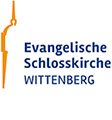History of the Castle Church
ca.1340 The Ascan Dukes have a chapel “All Saints” built adjacent to their Castle and create a collegial foundation to serve in the liturgies.
1489-1509 Elector Frederick the Wise orders the castle and its chapel be torn down, and has a new residential castle with a large castle church built.
1503 The not yet vaulted church is consecrated on January 17th as „All Saints“ church.
1507 The church becomes the academic chapel and auditorium of the Wittenberg University.
1517 Martin Luther makes public his 95 Theses against the abuse of the sale of indulgences, according to tradition, on the main door of the church (Nailing of the Theses).
1525 Frederick the Wise is buried in the church. Private Masses are discontinued and Lutheran worship is introduced.
1546 Martin Luther dies in Eisleben and is buried on February 22nd in the Castle Church.
1560 Phillip Melanchthon dies in Wittenberg and is buried in the Castle Church.
1760 A fire caused by an attack during the Seven-Years-War causes great damage to the Castle Church. Parts of the interior fixtures and the wooden Theses Doors are lost.
1770 The newly restored church is dedicated and the castle tower is remodeled to be the church tower.
1813 An attack in the War of Independence luckily only causes slight damage to the church, the tower and the bells however, are destroyed.
1815-1817 Wittenberg becomes part of Prussia. The University is moved to Halle and the church is given into the hands of the newly founded Preacher’s Seminary.
1848 Johann Hinrich Wichern declares to a large assembly that service and care to those suffering in the population is a duty of the Evangelical Church. Thus, he initiates the founding of what may be called “internal missions”.
1858 The new winged bronze theses doors, sponsored by King Frederick Wilhelm IV, are installed and the old entry is redone.
1885-1892 Both the church and the tower are remodeled in a Neogothic style as monuments to the Reformation.
1983 On the occasion of the 500th anniversary of Luther’s birthday, the Union of Evangelical Churches sponsors the making of 12 glas representations with portraits of reformers from different European countries. These portraits are created by Renate Brömme and installed in the lower side windows.
1989-90 From October 10th through March, prayer services of renewal are held after the collapse of the SED government.
1996 The church is added to the UNESCO World Heritage list.
1999-2000 After an intensive restoration of the church’s roof timbering, a new colorful glazed tile roof is added as it was in 1892.
2012-2016 General renovation of the castle church.




